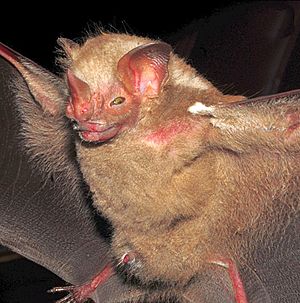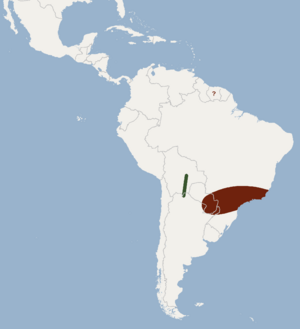Ipanema bat facts for kids
Quick facts for kids Ipanema bat |
|
|---|---|
 |
|
| Conservation status | |
| Scientific classification | |
| Genus: |
Pygoderma
|
| Species: |
bilabiatum
|
 |
|
The Ipanema bat (Pygoderma bilabiatum) is a cool type of bat that lives in parts of South America. It belongs to the order Chiroptera, which includes all bats. This bat is special because it's the only species in its group, called a genus. You can find these unique bats in northern Argentina, Bolivia, southeastern Brazil, and Paraguay.
Contents
About the Ipanema Bat
The Ipanema bat is a medium-sized bat. It has brown fur all over its body, but its shoulders are special because they are covered in white fur! The fur on its back is a darker brown than the fur on its chest. Males often have less fur on their shoulders and upper chest than females.
This bat has a short, somewhat square-shaped nose area (called a rostrum). It also has a large nose and no tail. Its ears are round, and inside each ear, there's a small flap called a tragus, which is about 4 to 5 millimeters long.
How big an Ipanema bat gets can depend on if it's a male or a female, and where it lives. Females are usually larger than males. Also, Ipanema bats from Argentina and Bolivia tend to have bigger skulls than those from Paraguay and Brazil. Most Ipanema bats have two molars (back teeth). However, some females might have a third molar, usually in their lower jaw, which males don't have. This extra tooth might be why females have larger jaws.
Both male and female Ipanema bats have special glands under their jaw and around their eyes. These glands are generally bigger in males. Males also have swollen areas on their front limbs (arms), which females do not have. The size and presence of these swellings can vary depending on where the bat lives. Scientists think these swellings might be linked to how males behave during mating.
Where Ipanema Bats Live
The Ipanema bat lives in northern Argentina, southeastern Brazil, Paraguay, and Bolivia. They prefer to live in tropical forests, subtropical forests, and secondary forests. Secondary forests are places where trees have grown back after being cut down. Sometimes, these bats are also found in the coastal shrublands of Brazil, which are drier areas with fewer trees. This suggests that the Ipanema bat might be able to live in different kinds of places, even those that are drier.
Ipanema Bat Diet and Reproduction
The Ipanema bat is a frugivorous animal, which means it mainly eats fruit. They especially like fruits that are easy to digest, very ripe, and soft, with only a few seeds. Their diet includes fruits from many different plants, such as Lucuma caimito, Miconia brasiliensis, and trees from the Celtis group. They also eat fruits from Maclura tinctoria, Solanum granuloso-leprosum, and Ficus enormis. Some Ipanema bats might also drink nectar from flowers.
Ipanema bats usually have their babies in the fall or winter. It's believed that they give birth towards the end of the dry season and stop feeding their young milk at the beginning of the wet season. This timing helps them make sure there's plenty of fruit available when their babies need it most. Female Ipanema bats usually carry only one baby at a time.
Ipanema Bat Behavior
The way Ipanema bats migrate (move from one place to another) might be affected by how much rain falls and the temperature. These bats seem to prefer areas that get at least 1500 millimeters (about 59 inches) of rain each year. They also like moderate temperatures, usually between 16 and 23 degrees Celsius (61 to 73 degrees Fahrenheit). Having enough food and being able to find it easily seems to be very important for when and how far they travel during migration.
Male and female Ipanema bats migrate differently. Males tend to stay in lower areas, while females prefer to live at middle and high elevations.
See also
 In Spanish: Pygoderma bilabiatum para niños
In Spanish: Pygoderma bilabiatum para niños


